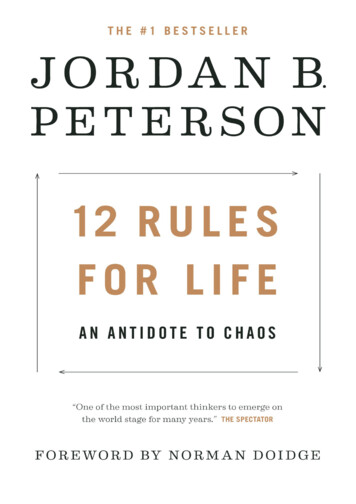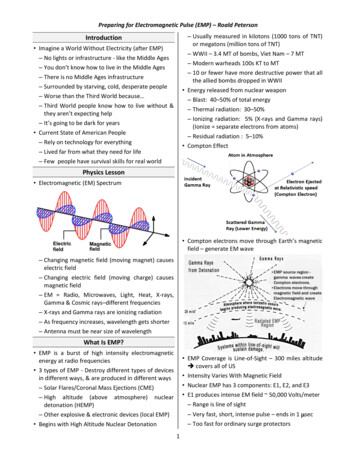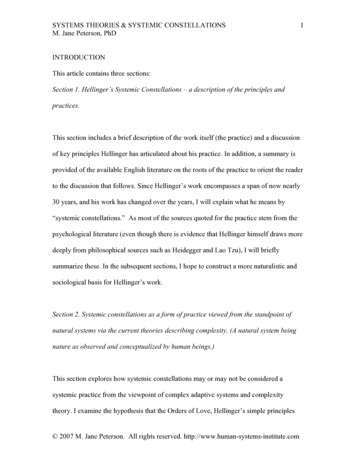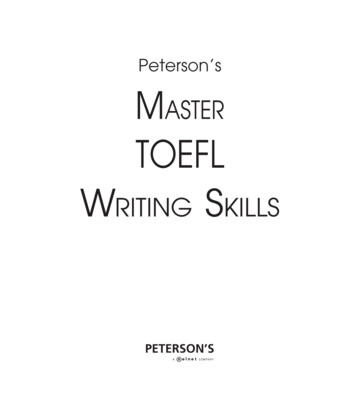
Transcription
2
Jordan B. Peterson12 RULES FOR LIFEAn Antidote for ChaosForeword by Norman DoidgeIllustrations by Ethan Van Scriver3
Table of ContentsForeword by Norman DoidgeOvertureRULE 1 / Stand up straight with your shoulders backRULE 2 / Treat yourself like someone you are responsible for helpingRULE 3 / Make friends with people who want the best for youRULE 4 / Compare yourself to who you were yesterday, not to who someone else is todayRULE 5 / Do not let your children do anything that makes you dislike themRULE 6 / Set your house in perfect order before you criticize the worldRULE 7 / Pursue what is meaningful (not what is expedient)RULE 8 / Tell the truth—or, at least, don’t lieRULE 9 / Assume that the person you are listening to might know something you don’tRULE 10 / Be precise in your speechRULE 11 / Do not bother children when they are skateboardingRULE 12 / Pet a cat when you encounter one on the streetCodaEndnotesAcknowledgementsFollow Penguin4
ForewordRules? More rules? Really? Isn’t life complicated enough, restricting enough, withoutabstract rules that don’t take our unique, individual situations into account? And giventhat our brains are plastic, and all develop differently based on our life experiences, whyeven expect that a few rules might be helpful to us all?People don’t clamour for rules, even in the Bible as when Moses comes down themountain, after a long absence, bearing the tablets inscribed with ten commandments,and finds the Children of Israel in revelry. They’d been Pharaoh’s slaves and subject to histyrannical regulations for four hundred years, and after that Moses subjected them to theharsh desert wilderness for another forty years, to purify them of their slavishness. Now,free at last, they are unbridled, and have lost all control as they dance wildly around anidol, a golden calf, displaying all manner of corporeal corruption.“I’ve got some good news and I’ve got some bad news,” the lawgiver yells to them.“Which do you want first?”“The good news!” the hedonists reply.“I got Him from fifteen commandments down to ten!”“Hallelujah!” cries the unruly crowd. “And the bad?”“Adultery is still in.”So rules there will be—but, please, not too many. We are ambivalent about rules, evenwhen we know they are good for us. If we are spirited souls, if we have character, rulesseem restrictive, an affront to our sense of agency and our pride in working out our ownlives. Why should we be judged according to another’s rule?And judged we are. After all, God didn’t give Moses “The Ten Suggestions,” he gaveCommandments; and if I’m a free agent, my first reaction to a command might just bethat nobody, not even God, tells me what to do, even if it’s good for me. But the story ofthe golden calf also reminds us that without rules we quickly become slaves to ourpassions—and there’s nothing freeing about that.And the story suggests something more: unchaperoned, and left to our own untutoredjudgment, we are quick to aim low and worship qualities that are beneath us—in thiscase, an artificial animal that brings out our own animal instincts in a completelyunregulated way. The old Hebrew story makes it clear how the ancients felt about ourprospects for civilized behaviour in the absence of rules that seek to elevate our gaze andraise our standards.One neat thing about the Bible story is that it doesn’t simply list its rules, as lawyers orlegislators or administrators might; it embeds them in a dramatic tale that illustrates whywe need them, thereby making them easier to understand. Similarly, in this bookProfessor Peterson doesn’t just propose his twelve rules, he tells stories, too, bringing tobear his knowledge of many fields as he illustrates and explains why the best rules do notultimately restrict us but instead facilitate our goals and make for fuller, freer lives.The first time I met Jordan Peterson was on September 12, 2004, at the home of twomutual friends, TV producer Wodek Szemberg and medical internist Estera Bekier. It wasWodek’s birthday party. Wodek and Estera are Polish émigrés who grew up within theSoviet empire, where it was understood that many topics were off limits, and that casually5
questioning certain social arrangements and philosophical ideas (not to mention theregime itself) could mean big trouble.But now, host and hostess luxuriated in easygoing, honest talk, by having elegantparties devoted to the pleasure of saying what you really thought and hearing others dothe same, in an uninhibited give-and-take. Here, the rule was “Speak your mind.” If theconversation turned to politics, people of different political persuasions spoke to eachother—indeed, looked forward to it—in a manner that is increasingly rare. SometimesWodek’s own opinions, or truths, exploded out of him, as did his laugh. Then he’d hugwhoever had made him laugh or provoked him to speak his mind with greater intensitythan even he might have intended. This was the best part of the parties, and thisfrankness, and his warm embraces, made it worth provoking him. Meanwhile, Estera’svoice lilted across the room on a very precise path towards its intended listener. Truthexplosions didn’t make the atmosphere any less easygoing for the company—they madefor more truth explosions!—liberating us, and more laughs, and making the wholeevening more pleasant, because with de-repressing Eastern Europeans like the SzembergBekiers, you always knew with what and with whom you were dealing, and that franknesswas enlivening. Honoré de Balzac, the novelist, once described the balls and parties in hisnative France, observing that what appeared to be a single party was always really two. Inthe first hours, the gathering was suffused with bored people posing and posturing, andattendees who came to meet perhaps one special person who would confirm them in theirbeauty and status. Then, only in the very late hours, after most of the guests had left,would the second party, the real party, begin. Here the conversation was shared by eachperson present, and open-hearted laughter replaced the starchy airs. At Estera andWodek’s parties, this kind of wee-hours-of-the-morning disclosure and intimacy oftenbegan as soon as we entered the room.Wodek is a silver-haired, lion-maned hunter, always on the lookout for potential publicintellectuals, who knows how to spot people who can really talk in front of a TV cameraand who look authentic because they are (the camera picks up on that). He often invitessuch people to these salons. That day Wodek brought a psychology professor, from myown University of Toronto, who fit the bill: intellect and emotion in tandem. Wodek wasthe first to put Jordan Peterson in front of a camera, and thought of him as a teacher insearch of students—because he was always ready to explain. And it helped that he likedthe camera and that the camera liked him back.That afternoon there was a large table set outside in the Szemberg-Bekiers’ garden;around it was gathered the usual collection of lips and ears, and loquacious virtuosos. Weseemed, however, to be plagued by a buzzing paparazzi of bees, and here was this newfellow at the table, with an Albertan accent, in cowboy boots, who was ignoring them,and kept on talking. He kept talking while the rest of us were playing musical chairs tokeep away from the pests, yet also trying to remain at the table because this new additionto our gatherings was so interesting.He had this odd habit of speaking about the deepest questions to whoever was at thistable—most of them new acquaintances—as though he were just making small talk. Or, ifhe did do small talk, the interval between “How do you know Wodek and Estera?” or “Iwas a beekeeper once, so I’m used to them” and more serious topics would benanoseconds.One might hear such questions discussed at parties where professors and professionalsgather, but usually the conversation would remain between two specialists in the topic,off in a corner, or if shared with the whole group it was often not without someonepreening. But this Peterson, though erudite, didn’t come across as a pedant. He had theenthusiasm of a kid who had just learned something new and had to share it. He seemed6
to be assuming, as a child would—before learning how dulled adults can become—that ifhe thought something was interesting, then so might others. There was something boyishin the cowboy, in his broaching of subjects as though we had all grown up together in thesame small town, or family, and had all been thinking about the very same problems ofhuman existence all along.Peterson wasn’t really an “eccentric”; he had sufficient conventional chops, had been aHarvard professor, was a gentleman (as cowboys can be) though he did say damn andbloody a lot, in a rural 1950s sort of way. But everyone listened, with fascination on theirfaces, because he was in fact addressing questions of concern to everyone at the table.There was something freeing about being with a person so learned yet speaking in suchan unedited way. His thinking was motoric; it seemed he needed to think aloud, to use hismotor cortex to think, but that motor also had to run fast to work properly. To get toliftoff. Not quite manic, but his idling speed revved high. Spirited thoughts were tumblingout. But unlike many academics who take the floor and hold it, if someone challenged orcorrected him he really seemed to like it. He didn’t rear up and neigh. He’d say, in a kindof folksy way, “Yeah,” and bow his head involuntarily, wag it if he had overlookedsomething, laughing at himself for overgeneralizing. He appreciated being shown anotherside of an issue, and it became clear that thinking through a problem was, for him, adialogic process.One could not but be struck by another unusual thing about him: for an eggheadPeterson was extremely practical. His examples were filled with applications to everydaylife: business management, how to make furniture (he made much of his own), designinga simple house, making a room beautiful (now an internet meme) or in another, specificcase related to education, creating an online writing project that kept minority studentsfrom dropping out of school by getting them to do a kind of psychoanalytic exercise onthemselves, in which they would free-associate about their past, present and future (nowknown as the Self-Authoring Program).I was always especially fond of mid-Western, Prairie types who come from a farm(where they learned all about nature), or from a very small town, and who have workedwith their hands to make things, spent long periods outside in the harsh elements, andare often self-educated and go to university against the odds. I found them quite unliketheir sophisticated but somewhat denatured urban counterparts, for whom highereducation was pre-ordained, and for that reason sometimes taken for granted, or thoughtof not as an end in itself but simply as a life stage in the service of career advancement.These Westerners were different: self-made, unentitled, hands on, neighbourly and lessprecious than many of their big-city peers, who increasingly spend their lives indoors,manipulating symbols on computers. This cowboy psychologist seemed to care about athought only if it might, in some way, be helpful to someone.We became friends. As a psychiatrist and psychoanalyst who loves literature, I was drawnto him because here was a clinician who also had given himself a great books education,and who not only loved soulful Russian novels, philosophy and ancient mythology, butwho also seemed to treat them as his most treasured inheritance. But he also didilluminating statistical research on personality and temperament, and had studiedneuroscience. Though trained as a behaviourist, he was powerfully drawn topsychoanalysis with its focus on dreams, archetypes, the persistence of childhoodconflicts in the adult, and the role of defences and rationalization in everyday life. He wasalso an outlier in being the only member of the research-oriented Department ofPsychology at the University of Toronto who also kept a clinical practice.On my visits, our conversations began with banter and laughter—that was the smalltown Peterson from the Alberta hinterland—his teenage years right out of the movie7
FUBAR—welcoming you into his home. The house had been gutted by Tammy, his wife,and himself, and turned into perhaps the most fascinating and shocking middle-classhome I had seen. They had art, some carved masks, and abstract portraits, but they wereoverwhelmed by a huge collection of original Socialist Realist paintings of Lenin and theearly Communists commissioned by the USSR. Not long after the Soviet Union fell, andmost of the world breathed a sigh of relief, Peterson began purchasing this propaganda fora song online. Paintings lionizing the Soviet revolutionary spirit completely filled everysingle wall, the ceilings, even the bathrooms. The paintings were not there because Jordanhad any totalitarian sympathies, but because he wanted to remind himself of somethinghe knew he and everyone would rather forget: that hundreds of millions were murderedin the name of utopia.It took getting used to, this semi-haunted house “decorated” by a delusion that hadpractically destroyed mankind. But it was eased by his wonderful and unique spouse,Tammy, who was all in, who embraced and encouraged this unusual need for expression!These paintings provided a visitor with the first window onto the full extent of Jordan’sconcern about our human capacity for evil in the name of good, and the psychologicalmystery of self-deception (how can a person deceive himself and get away with it?)—aninterest we share. And then there were also the hours we’d spend discussing what I mightcall a lesser problem (lesser because rarer), the human capacity for evil for the sake ofevil, the joy some people take in destroying others, captured famously by the seventeenthcentury English poet John Milton in Paradise Lost.And so we’d chat and have our tea in his kitchen-underworld, walled by this odd artcollection, a visual marker of his earnest quest to move beyond simplistic ideology, left orright, and not repeat mistakes of the past. After a while, there was nothing peculiar abouttaking tea in the kitchen, discussing family issues, one’s latest reading, with thoseominous pictures hovering. It was just living in the world as it was, or in some places, is.In Jordan’s first and only book before this one, Maps of Meaning, he shares his profoundinsights into universal themes of world mythology, and explains how all cultures havecreated stories to help us grapple with, and ultimately map, the chaos into which we arethrown at birth; this chaos is everything that is unknown to us, and any unexploredterritory that we must traverse, be it in the world outside or the psyche within.Combining evolution, the neuroscience of emotion, some of the best of Jung, some ofFreud, much of the great works of Nietzsche, Dostoevsky, Solzhenitsyn, Eliade,Neumann, Piaget, Frye and Frankl, Maps of Meaning, published nearly two decades ago,shows Jordan’s wide-ranging approach to understanding how human beings and thehuman brain deal with the archetypal situation that arises whenever we, in our daily lives,must face something we do not understand. The brilliance of the book is in hisdemonstration of how rooted this situation is in evolution, our DNA, our brains and ourmost ancient stories. And he shows that these stories have survived because they stillprovide guidance in dealing with uncertainty, and the unavoidable unknown.One of the many virtues of the book you are reading now is that it provides an entrypoint into Maps of Meaning, which is a highly complex work because Jordan was workingout his approach to psychology as he wrote it. But it was foundational, because no matterhow different our genes or life experiences may be, or how differently our plastic brainsare wired by our experience, we all have to deal with the unknown, and we all attempt tomove from chaos to order. And this is why many of the rules in this book, being based onMaps of Meaning, have an element of universality to them.Maps of Meaning was sparked by Jordan’s agonized awareness, as a teenager growing up inthe midst of the Cold War, that much of mankind seemed on the verge of blowing up theplanet to defend their various identities. He felt he had to understand how it could be that8
people would sacrifice everything for an “identity,” whatever that was. And he felt he hadto understand the ideologies that drove totalitarian regimes to a variant of that samebehaviour: killing their own citizens. In Maps of Meaning, and again in this book, one ofthe matters he cautions readers to be most wary of is ideology, no matter who is peddlingit or to what end.Ideologies are simple ideas, disguised as science or philosophy, that purport to explainthe complexity of the world and offer remedies that will perfect it. Ideologues are peoplewho pretend they know how to “make the world a better place” before they’ve taken careof their own chaos within. (The warrior identity that their ideology gives them coversover that chaos.) That’s hubris, of course, and one of the most important themes of thisbook, is “set your house in order” first, and Jordan provides practical advice on how to dothis.Ideologies are substitutes for true knowledge, and ideologues are always dangerouswhen they come to power, because a simple-minded I-know-it-all approach is no matchfor the complexity of existence. Furthermore, when their social contraptions fail to fly,ideologues blame not themselves but all who see through the simplifications. Anothergreat U of T professor, Lewis Feuer, in his book Ideology and the Ideologists, observed thatideologies retool the very religious stories they purport to have supplanted, but eliminatethe narrative and psychological richness. Communism borrowed from the story of theChildren of Israel in Egypt, with an enslaved class, rich persecutors, a leader, like Lenin,who goes abroad, lives among the enslavers, and then leads the enslaved to the promisedland (the utopia; the dictatorship of the proletariat).To understand ideology, Jordan read extensively about not only the Soviet gulag, butalso the Holocaust and the rise of Nazism. I had never before met a person, bornChristian and of my generation, who was so utterly tormented by what happened inEurope to the Jews, and who had worked so hard to understand how it could haveoccurred. I too had studied this in depth. My own father survived Auschwitz. Mygrandmother was middle-aged when she stood face to face with Dr. Josef Mengele, theNazi physician who conducted unspeakably cruel experiments on his victims, and shesurvived Auschwitz by disobeying his order to join the line with the elderly, the grey andthe weak, and instead slipping into a line with younger people. She avoided the gaschambers a second time by trading food for hair dye so she wouldn’t be murdered forlooking too old. My grandfather, her husband, survived the Mauthausen concentrationcamp, but choked to death on the first piece of solid food he was given, just beforeliberation day. I relate this, because years after we became friends, when Jordan wouldtake a classical liberal stand for free speech, he would be accused by left-wing extremistsas being a right-wing bigot.Let me say, with all the moderation I can summon: at best, those accusers have simplynot done their due diligence. I have; with a family history such as mine, one develops notonly radar, but underwater sonar for right-wing bigotry; but even more important, onelearns to recognize the kind of person with the comprehension, tools, good will andcourage to combat it, and Jordan Peterson is that person.My own dissatisfaction with modern political science’s attempts to understand the riseof Nazism, totalitarianism and prejudice was a major factor in my decision to supplementmy studies of political science with the study of the unconscious, projection,psychoanalysis, the regressive potential of group psychology, psychiatry and the brain.Jordan switched out of political science for similar reasons. With these important parallelinterests, we didn’t always agree on “the answers” (thank God), but we almost alwaysagreed on the questions.Our friendship wasn’t all doom and gloom. I have made a habit of attending my fellowprofessors’ classes at our university, and so attended his, which were always packed, and I9
saw what now millions have seen online: a brilliant, often dazzling public speaker whowas at his best riffing like a jazz artist; at times he resembled an ardent Prairie preacher(not in evangelizing, but in his passion, in his ability to tell stories that convey the lifestakes that go with believing or disbelieving various ideas). Then he’d just as easily switchto do a breathtakingly systematic summary of a series of scientific studies. He was amaster at helping students become more reflective, and take themselves and their futuresseriously. He taught them to respect many of the greatest books ever written. He gavevivid examples from clinical practice, was (appropriately) self-revealing, even of his ownvulnerabilities, and made fascinating links between evolution, the brain and religiousstories. In a world where students are taught to see evolution and religion as simplyopposed (by thinkers like Richard Dawkins), Jordan showed his students how evolution,of all things, helps to explain the profound psychological appeal and wisdom of manyancient stories, from Gilgamesh to the life of the Buddha, Egyptian mythology and theBible. He showed, for instance, how stories about journeying voluntarily into theunknown—the hero’s quest—mirror universal tasks for which the brain evolved. Herespected the stories, was not reductionist, and never claimed to exhaust their wisdom. Ifhe discussed a topic such as prejudice, or its emotional relatives fear and disgust, or thedifferences between the sexes on average, he was able to show how these traits evolvedand why they survived.Above all, he alerted his students to topics rarely discussed in university, such as thesimple fact that all the ancients, from Buddha to the biblical authors, knew what everyslightly worn-out adult knows, that life is suffering. If you are suffering, or someone closeto you is, that’s sad. But alas, it’s not particularly special. We don’t suffer only because“politicians are dimwitted,” or “the system is corrupt,” or because you and I, like almosteveryone else, can legitimately describe ourselves, in some way, as a victim of something orsomeone. It is because we are born human that we are guaranteed a good dose ofsuffering. And chances are, if you or someone you love is not suffering now, they will bewithin five years, unless you are freakishly lucky. Rearing kids is hard, work is hard,aging, sickness and death are hard, and Jordan emphasized that doing all that totally onyour own, without the benefit of a loving relationship, or wisdom, or the psychologicalinsights of the greatest psychologists, only makes it harder. He wasn’t scaring thestudents; in fact, they found this frank talk reassuring, because in the depths of theirpsyches, most of them knew what he said was true, even if there was never a forum todiscuss it—perhaps because the adults in their lives had become so naively overprotectivethat they deluded themselves into thinking that not talking about suffering would insome way magically protect their children from it.Here he would relate the myth of the hero, a cross-cultural theme exploredpsychoanalytically by Otto Rank, who noted, following Freud, that hero myths are similarin many cultures, a theme that was picked up by Carl Jung, Joseph Campbell and ErichNeumann, among others. Where Freud made great contributions in explaining neurosesby, among other things, focusing on understanding what we might call a failed-hero story(that of Oedipus), Jordan focused on triumphant heroes. In all these triumph stories, thehero has to go into the unknown, into an unexplored territory, and deal with a new greatchallenge and take great risks. In the process, something of himself has to die, or be givenup, so he can be reborn and meet the challenge. This requires courage, something rarelydiscussed in a psychology class or textbook. During his recent public stand for free speechand against what I call “forced speech” (because it involves a government forcing citizensto voice political views), the stakes were very high; he had much to lose, and knew it.Nonetheless, I saw him (and Tammy, for that matter) not only display such courage, butalso continue to live by many of the rules in this book, some of which can be verydemanding.10
I saw him grow, from the remarkable person he was, into someone even more able andassured—through living by these rules. In fact, it was the process of writing this book,and developing these rules, that led him to take the stand he did against forced orcompelled speech. And that is why, during those events, he started posting some of histhoughts about life and these rules on the internet. Now, over 100 million YouTube hitslater, we know they have struck a chord.Given our distaste for rules, how do we explain the extraordinary response to his lectures,which give rules? In Jordan’s case, it was of course his charisma and a rare willingness tostand for a principle that got him a wide hearing online initially; views of his firstYouTube statements quickly numbered in the hundreds of thousands. But people havekept listening because what he is saying meets a deep and unarticulated need. And that isbecause alongside our wish to be free of rules, we all search for structure.The hunger among many younger people for rules, or at least guidelines, is greatertoday for good reason. In the West at least, millennials are living through a uniquehistorical situation. They are, I believe, the first generation to have been so thoroughlytaught two seemingly contradictory ideas about morality, simultaneously—at theirschools, colleges and universities, by many in my own generation. This contradiction hasleft them at times disoriented and uncertain, without guidance and, more tragically,deprived of riches they don’t even know exist.The first idea or teaching is that morality is relative, at best a personal “valuejudgment.” Relative means that there is no absolute right or wrong in anything; instead,morality and the rules associated with it are just a matter of personal opinion orhappenstance, “relative to” or “related to” a particular framework, such as one’s ethnicity,one’s upbringing, or the culture or historical moment one is born into. It’s nothing but anaccident of birth. According to this argument (now a creed), history teaches thatreligions, tribes, nations and ethnic groups tend to disagree about fundamental matters,and always have. Today, the postmodernist left makes the additional claim that onegroup’s morality is nothing but its attempt to exercise power over another group. So, thedecent thing to do—once it becomes apparent how arbitrary your, and your society’s,“moral values” are—is to show tolerance for people who think differently, and who comefrom different (diverse) backgrounds. That emphasis on tolerance is so paramount thatfor many people one of the worst character flaws a person can have is to be“judgmental.” fn1 And, since we don’t know right from wrong, or what is good, just aboutthe most inappropriate thing an adult can do is give a young person advice about how to live.And so a generation has been raised untutored in what was once called, aptly, “practicalwisdom,” which guided previous generations. Millennials, often told they have receivedthe finest education available anywhere, have actually suffered a form of seriousintellectual and moral neglect. The relativists of my generation and Jordan’s, many ofwhom became their professors, chose to devalue thousands of years of human knowledgeabout how to acquire virtue, dismissing it as passé, “not relevant” or even “oppressive.”They were so successful at it that the very word “virtue” sounds out of date, and someoneusing it appears anachronistically moralistic and self-righteous.The study of virtue is not quite the same as the study of morals (right and wrong, goodand evil). Aristotle defined the virtues simply as the ways of behaving that are mostconducive to happiness in life. Vice was defined as the ways of behaving least conduciveto happiness. He observed that the virtues always aim for balance and avoid the extremesof the vices. Aristotle studied the virtues and the vices in his Nicomachean Ethics. It was abook based on experience and observation, not conjecture, about the kind of happinessthat was possible for human beings. Cultivating judgment about the difference betweenvirtue and vice is the beginning of wisdom, something that can never be out of date.11
By contrast, our modern relativism begins by asserting that making judgments abouthow to live is impossible, because there is no real good, and no true virtue (as these tooare relative). Thus relativism’s closest approximation to “virtue” is “tolerance.” Onlytolerance will provide social cohesion between different groups, and save us from harmingeach other. On Facebook and other forms of social media, therefore, you signal your socalled virtue, telling everyone how tolerant, open and compassionate you are, and wait forlikes to accumulate. (Leave aside that telling people you’re virtuous isn’t a virtue, it’s selfpromotion. Virtue signalling is not virtue. Virtue signalling is, quite possibly, ourcommonest vice.)Intolerance of others’ views (no matter how ignorant or incoherent they may be) is notsimply wrong; in a world where there is no right or wrong, it is worse: it is a sign you areembarrassingly unsophisticated or, possibly, dangerous.But it turns out that many people cannot tolerate the vacuum—the chaos—which isinherent in life, but made
harsh desert wilderness for another forty years, to purify them of their slavishness. Now, free at last, they are unbridled, and have lost all control as they dance wildly around an idol, a golden calf, displaying all manner of corporeal corruption. “I’ve got some good news











